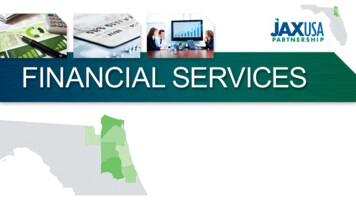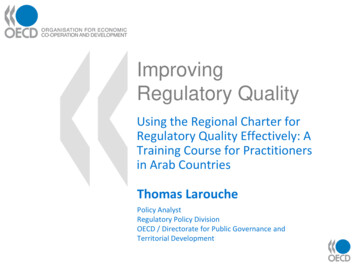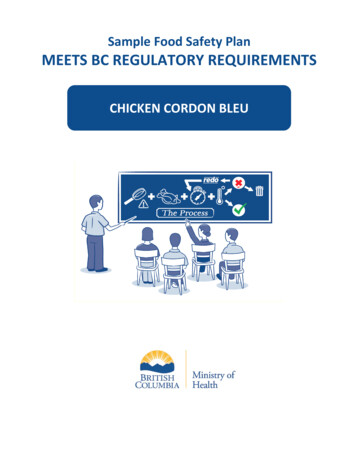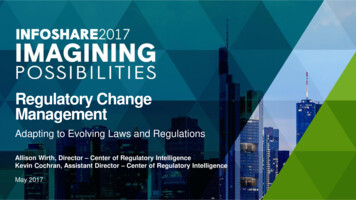
Transcription
Regulatory ChangeManagementAdapting to Evolving Laws and RegulationsAllison Wirth, Director – Center of Regulatory IntelligenceKevin Cochran, Assistant Director – Center of Regulatory IntelligenceMay 2017
EFFECTIVEREGULATORYCHANGEMANAGEMENTBEYOND ENTATIONSTRATEGIES ANDCONSIDERATIONS HMDAAmendments FinCENBeneficialOwnership RuleKEYTAKEAWAYS IncentiveCompensation2
3
The Changing Regulatory andEnforcement Climate4
President Trump – Financial Services PositionsDodd-Frank ActPriorities- President Trump (Reuters)““““Dodd-Frank has made it impossible forbankers to function. It makes it very hard forbankers to loan money for people to createjobs, for people with businesses to createjobs. And that has to stop.We’re going to be doing a bignumber on Reform- President Trump (White House)5
President Trump – Financial Services PositionsDodd-Frank Act (continued)““““Dodd-Frank has made it impossible forbankers to function. It makes it very hardfor bankers to loan money for people tocreate jobs, for people with businesses tocreate jobs. And that has to stop.We’re going to be doing a bignumber on Dodd-Frank.- President Trump (White House)- President Trump inancialReform6
Procedural Vehicles for Regulatory ChangeOptions available to the Trump Administration to address federal rulemaking under the Dodd-Frank Act Amendments Guidance Clarifications Moratoria Compliance Materials Policy Statements Enforcement Actions Reports Extension or postponement of effective dates Rulemaking Executive Orders Speeches Presidential Memoranda Technical Assistance Frequently Asked Questions Testimonies7
Executive Order: Core Principles for Regulating the U.S. FinancialSystemEmpower Americans to make independent financial decisions and informedchoices in the market place, save for retirement, and build individual wealthPrevent taxpayer-funded bailoutsCorePrinciplesFoster economic growth and vibrant financial markets through more rigorousregulatory impact analysis that addresses systemic risk and market failures,such as moral hazard and information asymmetryEnable American companies to be competitive with foreign firms in domesticand foreign marketsAdvance American interests in financial regulatory negotiations andmeetingsMake regulation efficient, effective, and appropriately tailoredRestore public accountability within Federal financial regulatory agenciesand rationalize the Federal regulatory frameworks8
Executive ActionPresidential MemorandumPresidential Memorandum on DOL Fiduciary Rule Directs the Department of Labor (DOL) to examine the fiduciary rule to determine whether if adverselyaffects the ability of Americans to gain access to retirement information and financial advice Prepare economic and legal analysis considering whether the fiduciary rule:– will harm or is likely to harm investors due to a cutback to products and services– will result in dislocations or disruptions within the retirement services industry– will likely cause an increase in litigation in the prices that investors and retirees must pay to gain access toretirement services If an affirmative determination is made for any of the three considerations above, or for any other reasonafter appropriate review, the DOL should publish for notice and comment a proposed rule rescinding orrevising the rule DOL has announced 60-day delay following the memorandum to June 99
Financial CHOICE Act OverviewCHOICE Act 2.0Eliminate the01 CAMELS02requirement fromthe capital election03Restructure theConsumer FinancialProtection Bureau(CFPB), UDAAPauthority repealed,and change whatfunctions the agencyis authorized toperform04Reduce the CCARstress-test cycle toevery two-years andeliminate the companyrun stress testRaise the SarbanesOxley 404(b) thresholdfrom 250 million to 500 million10
“Change managementprocesses are posing achallenge as banks allocateresources to implementprocesses and controls formultiple new or amendedregulations “ Office of the Comptroller of the Currency,Semiannual Risk Perspective, Fall 201611
Key Exam TopicsRisk Enterprise Risk Third Party (Vendor)Risk Management IncentiveCompensation Loans to Insiders/Regulation O Business ContinuityPlanningInformationSecurity Cybersecurity/Information Security GLBA/Privacy ofConsumer FinancialInformationCompliance ComplianceManagement System(CMS) Know Before You Owe(KBYO) AML/BSA/OFAC Fair Lending Anti-Bribery Fair Servicing Unfair, Deceptive orAbusive Acts orPractices (UDAAP) Complaint Management12
Soaring Legislative ComplexityFinancial Insights – Too Small to Succeed? Community Banks in a New Regulatory EnvironmentFrom 2001–2010, 10 major banking acts became law, totaling 1,858 pages13
2016-2017 Regulatory Road Map14
Enforcement TrendsSource: FIS Center of Regulatory Intelligence15
Effective Regulatory Change Management16
ChallengesInformation overloadInsufficient planning and timetablesRegulatory monitoring gapsLack of follow up and testingUnclear roles and authorityLack of evidence of tracking and/oranalyses of laws and regulationInadequate stakeholder involvementReactive vs. proactive regulatory changemanagement modesLack of clear change managementpolicy and processesDisjointed data17
Formula for SuccessPlanIdentifyTrack &MonitorAnalyzeImpactImplementReport18
Effective Regulatory Change ManagementOverview01Plan02Identify03Monitor andTrack04Analyze05Prioritize andAllocate06Execute07Report08Repeat19
Effective Regulatory Change Management0102020304PLANPlanIdentifyMonitor andTrackAnalyzeGovernance structure Policies and proceduresLines of reporting and points of contactSign off and escalationDocument managementBoard approval, if neededInvolve all stakeholders0506Prioritize andAllocate InternalThird partiesVendorsExecuteAmple timeline for implementation and testing07Report08RepeatDevelop lines of communication and reporting20
Effective Regulatory Change Management010202030405IDENTIFYPlanIdentifyMonitor andTrackAnalyzePrioritize andAllocate06Execute07Report08RepeatRegulatory Applicability Matrix Policies and proceduresProducts, services, customers, and business linesGeographic locationsEnforcement actions, fines, and penaltiesHigh-risk areas, operating environments, and risk tolerancesApplicable laws and regulations Governing bodiesRegulating authoritiesLegislatorsLaw enforcementSelf regulatory organization(s)21
Effective Regulatory Change Management010202030405MONITOR AND TRACKPlanIdentifyMonitor andTrackAnalyzePrioritize andAllocate06Execute07Report08RepeatMonitoring Cockpit Official and unofficial sourcesAnalyst monitoringSubject matter expert reviewing and testingRecordkeepingAssign frequency for each sourceControlsTracking Control documentsData feed(s)Manual tracking22
Effective Regulatory Change Management01020203040506ANALYZEPlanIdentifyMonitor andTrackAnalyzePrioritize andAllocateAnalyses Subject matter expertsGeneral CounselOutside CounselConsultantsAssociationsGovernment(s) and Regulator(s)Impact statements Vendor, SME, CounselRegulator summary or rule-to-ruleExecuteTimelines07Report08Repeat DeliverablesDeadlines23
Effective Regulatory Change Management010202030405PRIORITIZE AND ALLOCATEPlanIdentifyMonitor andTrackAnalyzePrioritize andAllocate06Execute07Report08RepeatPriority level Effective datesImplementation timelinesExtent of impactRisksResource allocation FinancialStaffThird parties24
Effective Regulatory Change Management010202030405EXECUTEPlanIdentifyMonitor andTrackAnalyzePrioritize andAllocate06Execute07Report08RepeatExecution Tone at the top – Board-to-basementCommunication keyFollow project planAdequate accountability and oversightAdapt and documentTest, test, and retestEducation Training and testingDocument25
Effective Regulatory Change Management010202030405REPORTPlanIdentifyMonitor andTrackAnalyzeReporting MilestonesSetbacksLessons learnedRegular intervalsRegulatory reporting libraryArchivePrioritize andAllocate06Execute07Report08Repeat26
Effective Regulatory Change Management010202030405REPEATPlanIdentifyMonitor andTrackBest in class Evolutionary and dynamicReevaluate as needed, but no less than annuallyLearn from past successes and mistakesAnalyzePrioritize andAllocate06Execute07Report08Repeat27
Beyond the Basics:Advanced Regulatory Change Management28
Advanced Regulatory Change Management29
Advanced Regulatory Change ManagementU.S. CongressCongressionalSourcesPrivate and PublicSector Sources Committee Members and Trade, Business, and ConsumerState/Congressional District Committee Jurisdiction –Authorization and Appropriations Political Action Committee (PAC) Legislation – Analyses fromIntroduction-to-LawAssociations – Statements,Lobbying, and Campaigns News and Industry Publications Banks and Financial Institutions –Lobbying Registrations andReports–––Committee Action – Hearings,Statements, Congressional Record,VotesFloor Debate – Statements, Votes,and Congressional RecordLegislation – Legislation, Reports,and Appropriations30
Advanced Regulatory Change ManagementU.S. GovernmentPublic and PrivateSector SourcesFederal GovernmentSources Primary Regulator – U.S. Federal Reserve; CFPB; FDIC; OCCSecondary Department andAgencies – U.S. Department ofDefense; U.S. Department ofAgricultureU.S. Congress – Members ofCongress and CommitteesCouncils – National EconomicCouncil (NEC); National SecurityCouncil (NSC)Office of Management and Budget(OMB) Trade, Business, and Consumers AssociationsLobbying Firms – Private Sectorand Public SectorLaw FirmsConsultantsVendorsU.S. Courts31
Advanced Regulatory Change ManagementCFPB’s Consumer Complaint Database and Consumer Response Annual ReportSource: CFPB Consumer Response Annual Report, December 201632
Implementation Strategies and Considerations:- HMDA Amendments- FinCEN Beneficial Ownership Rule- Incentive Compensation33
HMDA AmendmentsTimeline34
HMDA AmendmentsData Fields NOT Changing35
HMDA AmendmentsModified Data Fields Legal Entity Identifier (LEI) Loan status Universal Loan Identifier (ULI) Denial reason Loan purpose Property address Preapproval request Age Construction method Credit score Occupancy type Total loan costs or total points and fees Loan amount Origination charges Ethnicity, race and sex Discount points Income Lender credits Type of purchaser Interest rates Rate spread36
HMDA AmendmentsNew Data Fields Prepayment penalty term Debt to Income Ratio (DTI) Combined Loan to Value Ratio(CLTV) Loan terms Introductory rate period Non-amortizing features Manufactured home securedproperty type Manufactured home land interestproperty Total units Multifamily affordable units Mortgage Loan OriginatorNMLSR Identifier Property value37
New Data Fields Total loan costs or total pointsand fees Property address Age Credit score Origination charges Discount points Lender credits Interest rates he HMDA Automatedunderwritingsystemelectronically. LARReversemortgages Open-end line of creditAllHMDA reportable Business or commercial purposeinstitutions will use a newinternet-basedsubmission tool in 2018.38
FinCEN Beneficial Ownership RuleCustomer Due Diligence INSTITUTIONSJuly 11, 2016May 11, 2018Covered Institutions arerequired to identify thebeneficial owners of newlegal entity customersKEYDEFINITIONS Covered Institution Legal Entity Customer Beneficial Owner39
FinCEN Beneficial Ownership RuleFifth Pillar to AML Program RequirementsCovered institutions required to gain anunderstanding of the nature andpurpose of relationships in order to: Develop a customerrisk profile Conduct ongoing monitoringfor reporting suspicious transactions, and Maintain and update customer informationusing a risk-based approach40
FinCEN Beneficial Ownership RuleRequirements to Identify Beneficial Ownership Maintain written procedures as part of AML compliance program to identify a natural personowner for each legal entity customer opening new accounts who meet the following criteria: Reliance– Covered institutions may relay on other financial institutions to perform the requirements to identify beneficialownership provided that the covered institution has no knowledge of facts that would reasonably call into questionthe reliability of the information. Maintenance– Information must be updated on an event-driven basis not an ongoing basis41
FinCEN Beneficial Ownership RuleKey Requirements42
Incentive CompensationKey RequirementsDodd-Frank Act Section 956FDIC Guidance on Sound Incentive Compensation PoliciesFederal Reserve Incentive Compensation Practices StudyCFPB Compliance Bulletin 2016-03Dodd-Frank Act Section 953(b)Dodd-Frank Act Section 951Enforcement43
Key Takeaways44
Touchpoints45
Formula for SuccessINFORMATION1Cover final state and federal laws and newsas secondary sourcesCOMMUNICATIONS5BUSINESS STRATEGY2Include Compliance in strategy and productand service developmentEXPERTISE36Ensure appropriate knowledge andproficiency for internal and external staffingand vendors7EXISTING RESOURCES4Articulate clear expectations and behavioralguidelines for internal and external stakeholders,customers, and governmentsVISIONCompliance adds vision enterprise-wide andimproves overall business strategy and revenueENFORCEMENT ACTIONSReview to identify trends and emerging risksIntegrate government affairs, general counsel,and communications46
Visit us in the expo hallto learn moreQuestions?Sign up for free, monthly Regulatory Intelligence irth@fisglobal.comKevin.Cochran@fisglobal.com
Effective Regulatory Change Management 21 IDENTIFY Regulatory Applicability Matrix Policies and procedures Products, services, customers, and business lines Geographic locations Enforcement actions, fines, and penalties High-risk areas, operating environments, and risk tolerances Applicable laws and regulations Governing .


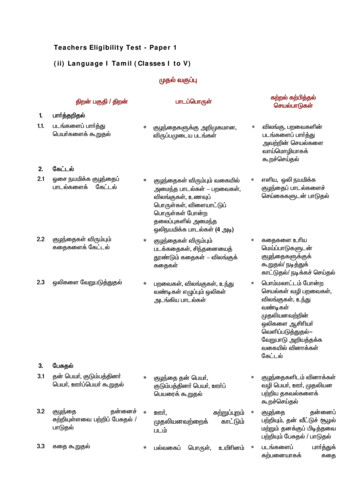
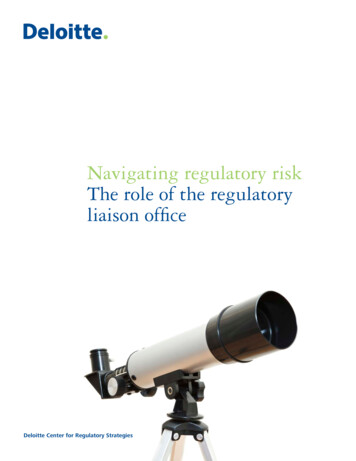
![Change Management Process For [Project Name] - West Virginia](/img/32/change-20management-20process-2003-2022-202012.jpg)

